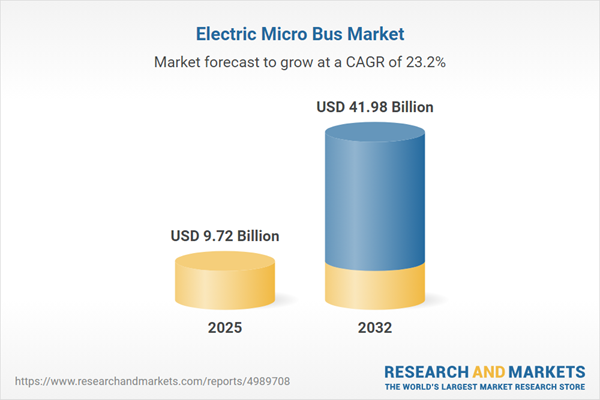Speak directly to the analyst to clarify any post sales queries you may have.
Senior executives are swiftly embracing the electric microbus market as a pillar of sustainable city mobility, driving operational modernization amid evolving policies and growing city transit demands. As urban stakeholders prioritize fleet efficiency and compliance, future-ready strategies are essential for securing lasting leadership in this dynamic environment.
Market Snapshot: Electric Microbus Market Outlook
The global electric microbus market is growing decisively, backed by increased investor confidence and a rising emphasis on robust electric vehicle infrastructure. Strict emission standards are prompting municipal authorities and fleet operators to adopt compact, zero-emission microbuses, which align with public demands for cleaner urban transit. Centralized digital platforms are increasingly used for seamless fleet management and integration with established transport and logistics solutions. Real-time analytics and modular deployment models contribute to broader adoption and improved reliability, embedding electric microbuses as essential assets within urban and sustainable transit initiatives. These advances help align organizational agendas with broader urban sustainability goals and transformation plans.
Scope & Segmentation: Strategic Insights for the Electric Microbus Market
This in-depth report provides senior decision-makers with the practical guidance needed for procurement and modernization, equipping them for regulatory and operational shifts in global fleet management. The structured segmentation framework connects the latest technology applications, regulation trends, and market offerings with tailored business objectives across regions.
- Propulsion Type: Battery electric, fuel cell electric, and hybrid models let fleets align with present emission guidelines and adapt energy sources to local conditions.
- Seating Capacity: Variants serving under 10, 10–15, and over 15 passengers support flexible deployment—from specialized use cases to high-throughput urban corridors—facilitating scalable growth strategies.
- Operating Range: Intra-city and intercity options support consistent service over diverse geographies, empowering executives to match technical parameters with their deployment strategies.
- Battery Capacity: Selections below 100 kWh, between 100–200 kWh, and above 200 kWh enable alignment with resource goals and operational efficiency requirements for complex, multi-shift operations.
- Application: Use cases include last-mile delivery, school and enterprise shuttles, public transit, and commuter services, allowing leaders to match vehicle capabilities to specific business priorities and compliance demands.
- Ownership Type: Leasing, government fleet deployment, and private ownership allow tailored capital management and asset optimization across organizational models.
- Regional Coverage: Analysis across the Americas, EMEA, and Asia-Pacific enables stakeholders to understand the influence of regional regulation, supply chain resilience, and market entry strategy.
- Leading Companies Analyzed: Technology trends and innovation pipelines from market participants—including BYD, Zhengzhou Yutong, Xiamen King Long, Anhui Ankai, Zhongtong Bus, Proterra, Karsan, EasyMile, Navya, and TATA Motors—offer benchmarks for competitive positioning and partnership opportunities.
Key Takeaways for Senior Executives in the Electric Microbus Market
- Modular microbus designs enable rapid adaptation to new regulatory requirements and fluctuations in transit demand, bolstering operational flexibility and compliance readiness.
- Ongoing investment in battery innovation and infrastructure supports robust performance, long-term fleet reliability, and improved energy management across variable deployment environments.
- Digital fleet management platforms are driving significant enhancement in predictive maintenance, operational transparency, and cost optimization, helping organizations maintain peak fleet uptime.
- Creative public-private partnership models have emerged to provide expanded procurement options, promoting shared risk and flexible lifecycle management for both municipal and private-sector fleets.
- Localized supply chains help safeguard operational continuity in regions with intricate compliance obligations, while streamlining component access and reducing exposure to cross-border disruption.
- Real-time telematics solutions are strengthening fleet utilization and responsiveness, equipping leaders to adapt to dynamic urban and regional transit patterns efficiently.
Tariff Impact on Market Dynamics
Recently introduced tariffs in the United States on electric vehicle batteries and core electronics are raising operational expenses for electric microbus manufacturers. To offset these pressures, many firms are shifting production closer to end markets and deepening relationships with local suppliers. These supply chain adjustments are bolstering operational resilience while requiring new approaches to regulatory and pricing strategy, influencing both North American market dynamics and broader global trends.
Methodology & Data Sources
This analysis is grounded in comprehensive secondary research, direct interviews with market leaders, suppliers, and operators, and systematic regulatory assessments. All insights are validated through stringent peer review, ensuring data accuracy and objectivity for executive-driven decisions in the electric microbus market.
Why This Report Matters
- Presents actionable guidance to help organizations anticipate and adapt to operational and compliance shifts, supporting strategic agility and risk mitigation.
- Delivers investor-ready intelligence that distills changes in electrification and regulatory frameworks for informed benchmarking and confident decision-making.
- Enables alignment of operations with fast-evolving market demands, keeping stakeholders prepared for future developments in sustainable urban transport.
Conclusion
Adopting advanced technology, resilient supply strategies, and flexible operational models empowers organizations to drive ongoing success in the electric microbus market. Strategic openness and active sector collaboration will remain central to sustained growth and leadership.
Additional Product Information:
- Purchase of this report includes 1 year online access with quarterly updates.
- This report can be updated on request. Please contact our Customer Experience team using the Ask a Question widget on our website.
Table of Contents
3. Executive Summary
4. Market Overview
7. Cumulative Impact of Artificial Intelligence 2025
Companies Mentioned
The companies profiled in this Electric Micro Bus market report include:- BYD Company Limited
- Zhengzhou Yutong Bus Co., Ltd
- Xiamen King Long United Automotive Industry Co., Ltd
- Anhui Ankai Automobile Co., Ltd
- Zhongtong Bus Co., Ltd
- Proterra Inc.
- Karsan Otomotiv Sanayi ve Ticaret A.Ş.
- EasyMile SAS
- Navya SA
- TATA Motors Limited
Table Information
| Report Attribute | Details |
|---|---|
| No. of Pages | 186 |
| Published | November 2025 |
| Forecast Period | 2025 - 2032 |
| Estimated Market Value ( USD | $ 9.72 Billion |
| Forecasted Market Value ( USD | $ 41.98 Billion |
| Compound Annual Growth Rate | 23.2% |
| Regions Covered | Global |
| No. of Companies Mentioned | 11 |









